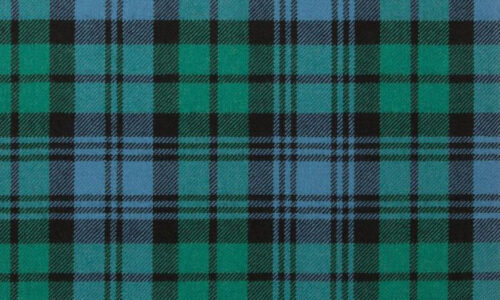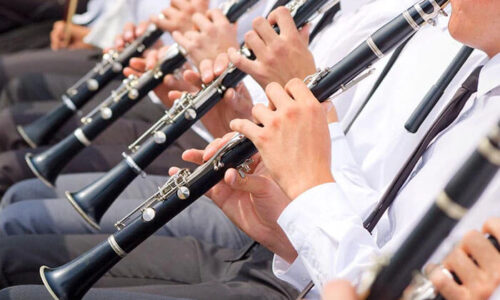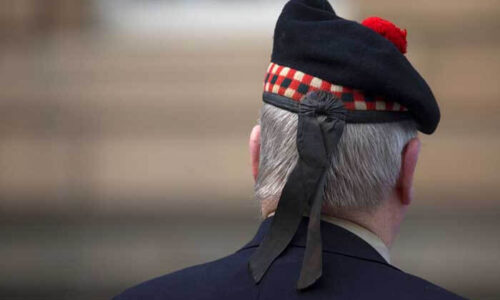Are you fascinated by military-inspired fashion and want to create your own stunning Hussar jacket? This comprehensive guide will walk you through every step of making a professional-quality Hussar jacket from scratch. Whether you’re a beginner seamstress or an experienced tailor, this detailed tutorial will help you create a show-stopping piece that rivals any designer jacket.
A Hussar jacket is a military-inspired garment that originated from the ornate uniforms worn by Hungarian light cavalry soldiers called Hussars. These jackets are characterized by their distinctive features: high stand collars, decorative gold braiding, multiple rows of buttons, and intricate frogging details. Today, Hussar jackets have become a popular fashion statement, appearing on runways and in wardrobes of fashion enthusiasts who love bold, structured pieces.
Why Choose Scotland Kilt Collection for Your Hussar Jacket Needs?
While making your own Hussar jacket is rewarding, sometimes you need professional quality or lack the time for DIY construction. Scotland Kilt Collection offers exceptional Hussar jackets that combine traditional craftsmanship with modern convenience.
Why Scotland Kilt Collection Stands Out:
- Authentic Military Styling: Each jacket features historically accurate details including proper braiding patterns, military-grade buttons, and traditional frog closures
- Premium Materials: High-quality wool suiting and luxurious satin linings ensure durability and comfort
- Expert Craftsmanship: Professional tailors create each piece with attention to traditional construction methods
- Custom Fitting Options: Available in multiple sizes with alteration services for perfect fit
- Complete Accessories: Matching accessories including military-style buttons, braiding, and ceremonial elements
- Time-Saving Solution: Skip months of construction time while getting professional results
- Historical Accuracy: Designs based on authentic military uniforms with proper proportions and details
Perfect for These Occasions:
- Military ceremonies and formal events
- Renaissance fairs and historical reenactments
- Theater productions and costume requirements
- Special occasions requiring formal military attire
- Professional photography and fashion shoots
- Collectors of military-inspired fashion
Scotland Kilt Collection’s Hussar jackets provide the perfect balance of authenticity, quality, and convenience. Whether you’re participating in ceremonial events, theatrical productions, or simply want to add military-inspired elegance to your wardrobe, their expertly crafted pieces deliver professional results without the time investment of DIY construction.
However, if you enjoy the satisfaction of creating your own garments and want to customize every detail to your preferences, making your own Hussar jacket remains an incredibly rewarding project. The choice between purchasing and making depends on your timeline, skill level, and personal preferences.
What You’ll Need – Complete Materials List
Before starting your DIY Hussar jacket project, gather all necessary materials to ensure smooth construction. Here’s your complete shopping list:
Main Fabrics:
- Navy or black suiting/twill: 2.5–3 meters (depending on size)
- Lining fabric (satin/taffeta): 2–2.5 meters
- Choose high-quality materials for durability and professional appearance
Structure Materials:
- Fusible interfacing: 1 meter (for collar, cuffs, front panels)
- Canvas/haircloth: 0.5 meter (optional but recommended for structure)
- Medium-weight interfacing works best
Decorative Elements:
- Gold military braid: 10–15 meters (depending on design rows)
- Metal buttons: 20–30 pieces (various sizes for main closure and decoration)
- Frogs/toggles: 4–6 pieces for authentic military styling
- Hook & bar closures or hidden zipper
Essential Tools:
- Sharp fabric scissors and rotary cutter
- Measuring tape and tailor’s chalk
- Pins, hand needles, and sewing machine
- Iron with press cloth
- Ruler for straight braid lines
Having quality materials and tools makes the entire process smoother and your results more professional.
Step 1: Taking Perfect Measurements
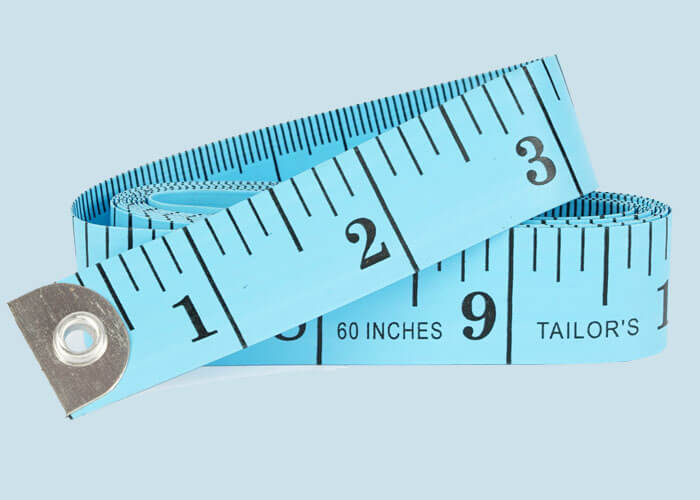
Start your Hussar jacket journey by taking accurate body measurements, as proper fit is crucial for achieving that sharp military look.
Required Measurements:
- Chest: Around the fullest part
- Waist: Natural waistline measurement
- Hip: Fullest part of your hips
- Back length: From neck to desired hem
- Sleeve length: From shoulder to wrist
- Bicep: Around fullest part of upper arm
- Neck: Comfortable fit around neck base
Pro Measuring Tips:
- Wear fitted clothing for accuracy
- Keep measuring tape level but not tight
- Have someone help for back measurements
- Record all measurements and double-check
- Add ease allowances per pattern instructions
Remember that a military-style jacket should fit close to the body while allowing comfortable movement, so don’t add excessive ease that will compromise the tailored silhouette.
Step 2: Preparing Your Pattern
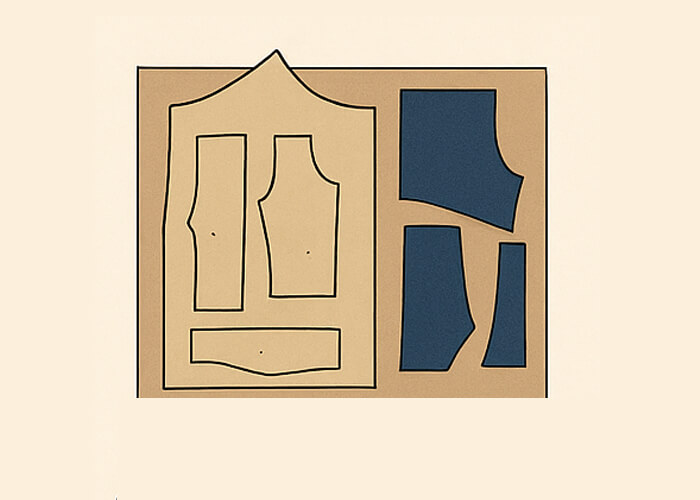
Transform a basic jacket pattern into authentic Hussar styling through careful modifications.
Pattern Modifications Needed:
- Adjust length to waist-length or slightly longer
- Add 2–3 cm overlap to front panels for button closure
- Create waist shaping using side panels or princess seams
- Design stand collar with 3.5–4.5 cm height
- Plan two-piece sleeve construction for better fit
- Add 1.5 cm seam allowances throughout
Pattern Pieces You’ll Need:
- Front panels (with overlap)
- Back piece (center or side seams)
- Side panels for waist shaping
- Stand collar pieces
- Two-piece sleeves (upper and under)
- Decorative cuffs
- Lining pieces matching main pattern
Mark all pattern pieces clearly with construction details, notches, and grain lines. Consider making a test garment in muslin first, especially if you’re modifying the pattern significantly or working with expensive fabric.
Step 3: Cutting Your Fabrics

Prepare your workspace with a large, flat cutting surface and ensure your fabrics are properly prepared. Pre-shrink all fabrics according to their care instructions, then press thoroughly to remove wrinkles. Check that fabric is on-grain before laying out pattern pieces.
Lay pattern pieces on your main fabric following grain lines carefully. Consider fabric design and nap direction if applicable. Plan your cutting layout efficiently to minimize waste while ensuring all pieces fit comfortably on your fabric. Pin pattern pieces securely and cut with sharp fabric scissors for clean edges.
Transfer all pattern markings to your fabric pieces using tailor’s chalk or fabric markers. Cut your lining using the same pattern pieces, adding slight ease for comfort. Apply fusible interfacing to collar pieces, cuff pieces, and front edges immediately after cutting to prevent pieces from stretching out of shape.
Step 4: Constructing the Jacket Body
Begin construction by joining your main body pieces in the proper sequence. Start with any darts or princess seams marked on your pattern, stitching these carefully and pressing toward the center or as indicated. Join front panels to side panels, ensuring smooth seam lines and matching notches precisely.
Attach the side panels to the back piece, creating the basic jacket shell. Stitch shoulder seams with care to ensure even distribution and smooth curves. Press all seams as you go, using appropriate heat settings for your fabric. Each seam should be pressed before being crossed by another seam for professional results.
Check your work frequently by trying on the jacket shell. Both sides should be symmetrical, armholes should be smooth and even, and the waist shaping should create a flattering silhouette without being too tight. Make any necessary adjustments before proceeding to the next steps.
Step 5: Making and Attaching Sleeves
Create professional two-piece sleeves by joining the upper and under sleeve pieces with careful attention to easing around curves. Use a sleeve board or pressing ham to press seams smoothly without creating unwanted creases. Mark cuff attachment points evenly around the sleeve opening.
Prepare the sleeve head by adding slight ease at the shoulder point, which allows the sleeve to hang naturally from the shoulder. Pin sleeves into armholes carefully, matching all notches and distributing ease evenly across the sleeve head. The sleeve should set into the armhole without pulling or puckering.
Stitch sleeves to the body slowly and carefully, checking frequently that seams remain smooth. Trim and grade seam allowances appropriately to reduce bulk. Press armhole seams toward the body for a clean finish. Consider adding interfacing to the sleeve head for additional structure if desired.
Step 6: Creating the Stand Collar
The stand collar is a defining feature of Hussar jackets and requires precision for authentic appearance. Interface your collar pieces with appropriate interfacing to provide structure without excessive stiffness. Stitch collar pieces together, creating smooth curves and clean seam lines.
Trim and grade seam allowances to reduce bulk, then turn the collar right side out and press carefully. The collar should maintain its shape while being flexible enough for comfortable wear. Understitch the seam allowances to prevent rolling and maintain crisp edges.
Attach the completed collar to the jacket neckline, pinning carefully to distribute ease evenly. The collar should sit properly around the neck without gaping or binding. Stitch securely and finish seam allowances appropriately for durability.
Step 7: Making Decorative Cuffs
Create structured cuffs that complement your jacket’s military styling. Interface cuff pieces for proper body and shape retention. Create clean finished edges before attaching to sleeve openings. The cuffs should fit comfortably over hands while maintaining their structured appearance.
Mark button placement on cuffs according to your design plan, typically 3 to 4 buttons per cuff for authentic styling. Attach cuffs to sleeve openings with careful attention to even distribution and smooth seam lines. Add decorative braiding to cuffs before final attachment if your design includes this detail.
Test cuff function by checking that they allow comfortable hand passage while maintaining their shape. Secure all seam allowances and press carefully to set the shape permanently.
Step 8: Planning and Applying Gold Braiding
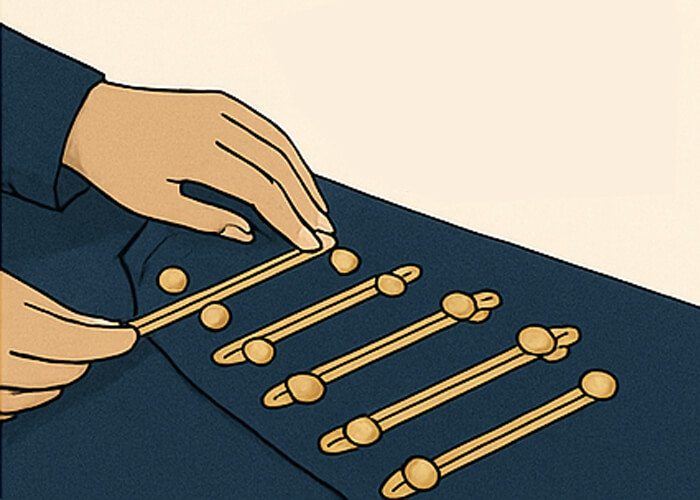
The decorative braiding transforms your basic jacket into an authentic Hussar masterpiece and requires careful planning.
Braiding Layout Process:
- Mark horizontal rows 4–5 cm apart across jacket front
- Use tailor’s chalk and ruler for straight, even lines
- Calculate braid length for each row plus extra for finishing
- Start from center and work outward for balance
- Ensure left and right sides mirror perfectly
Application Technique:
- Pin braid securely before stitching
- Use matching thread for invisible attachment
- Stitch close to both edges with straight stitch
- Keep lines perfectly straight throughout
- Press lightly after application to set shape
Design Considerations:
- Traditional spacing: 4–5 rows across front
- Braid width: 1–2 cm works best for most designs
- Add decorative intersections at strategic points
- Create corner treatments for professional finish
Apply braid using careful attention to symmetry and spacing. The braiding pattern is what makes your jacket authentically military in appearance.
Step 9: Creating Authentic Frog Closures
Traditional frog closures add authentic military styling and functional beauty to your Hussar jacket. You can purchase ready-made frogs or create custom ones using your gold braid material. Plan frog placement at strategic points along the jacket front, typically 4 to 6 closures depending on jacket length.
If making your own frogs, create loops and knots using your braid material, securing with careful hand stitching. Each frog should be identical in size and shape for professional appearance. Position frogs so they align with your planned button placement for both decorative and functional purposes.
Attach frogs securely to the jacket using strong thread and reinforcing stitches. The closures should be both beautiful and functional, able to withstand regular use without loosening or breaking.
Step 10: Strategic Button Placement and Installation

Plan your button placement to enhance both function and visual appeal.
Button Planning Strategy:
- Main closure: 6–8 large buttons down front opening
- Decorative buttons: Smaller ones at braid intersections
- Cuff buttons: 3–4 buttons per cuff for authenticity
- Ensure even spacing and perfect alignment
Button Selection Guidelines:
- Choose military-style brass or gold-colored buttons
- Use consistent style and finish throughout
- Various sizes: larger for closures, smaller for decoration
- Quality metal buttons for durability and appearance
Installation Best Practices:
- Mark all positions carefully before installation
- Use strong thread for high-stress areas
- Create thread shanks for thick fabrics
- Test function with buttonholes or frog closures
- Reinforce attachment points for longevity
Proper button placement and installation separates professional results from amateur construction. Take time to plan placement for both aesthetic appeal and functional use.
Step 11: Installing the Lining
Professional lining installation separates amateur projects from couture-quality results. Construct your lining using the same sequence as your main jacket but with slightly more ease for comfortable movement. Press all lining seams carefully for smooth interior appearance.
Pin lining to jacket interior, matching seams and construction details carefully. The lining should lie smoothly without pulling or binding. Attach lining to facing edges using appropriate seam allowances, creating clean finished edges throughout the interior.
Install your chosen closure system, whether traditional hooks and bars or a hidden zipper for modern convenience. Complete all hem finishes with care, ensuring the lining hangs properly without showing from the exterior.
Step 12: Final Finishing and Pressing
Give your completed jacket a thorough final pressing using appropriate heat settings and pressing cloths to protect decorative elements. Press carefully around braiding and buttons to avoid damage while setting all seams and construction details permanently.
Trim any remaining loose threads and inspect all construction details for security. Check that all buttons are firmly attached, braiding is secure, and seam finishes are complete. Make any needed touch-up repairs before considering the jacket complete.
Try on your finished jacket for final fit evaluation. Check that all closures function smoothly, the jacket hangs properly, and the fit is comfortable for intended use. Make any final minor adjustments needed for perfect fit and function.
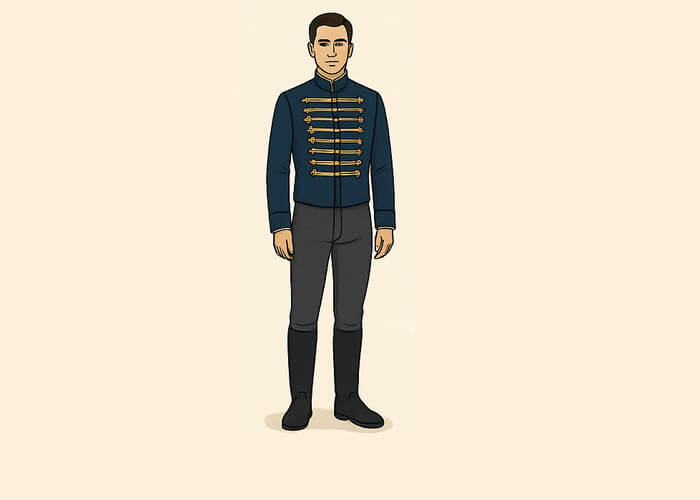
Styling Your Handmade Hussar Jacket
Your completed Hussar jacket offers versatility for various styling occasions. For formal events, pair with tailored trousers and dress shirts for sophisticated military-inspired elegance. Add coordinating accessories like pocket watches or military-style medals for authentic period styling.
For contemporary casual wear, style your jacket with well-fitted jeans and simple tops for elevated everyday fashion. The structured military styling adds interesting contrast to casual pieces while maintaining wearable comfort. Mix with modern accessories for eclectic personal style expression.
Consider seasonal adaptability when building outfits around your jacket. Layer over lightweight sweaters in cooler weather, or use as a structured outer layer in transitional seasons. The timeless military styling works across multiple fashion trends and seasonal changes.
Professional Maintenance and Care
Maintain your handmade investment through proper care and storage techniques. Professional dry cleaning preserves the structure and decorative elements better than home washing. Store on padded hangers to maintain shape between wears, and allow adequate air circulation to prevent moisture buildup.
Inspect buttons and braiding periodically, reattaching any loose elements promptly to prevent damage. Store in breathable garment bags for long-term storage, avoiding plastic bags that can trap moisture. Keep in cool, dry environments away from direct sunlight.
Consider seasonal maintenance checks, especially if the jacket is worn frequently. Professional alterations can address any fit changes over time, and expert cleaning can refresh the appearance and extend the garment’s lifespan significantly.
Creating a Hussar jacket from scratch represents a significant achievement in sewing and fashion construction. This project develops advanced tailoring skills while producing a unique, personalized garment that reflects individual style and craftsmanship. The combination of traditional military styling with modern construction techniques creates a timeless piece worthy of any designer collection.
Your completed jacket serves as testament to dedicated craftsmanship and creative vision. The satisfaction of wearing a completely handmade garment, tailored to exact specifications and personal preferences, makes every hour of construction effort worthwhile. This project not only produces a beautiful jacket but also builds comprehensive sewing skills applicable to future fashion projects.


